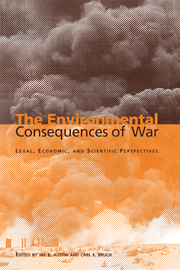Book contents
- Frontmatter
- Contents
- List of illustrations
- List of tables
- List of contributors
- Acknowledgements
- Foreword by Klaus Toepfer
- Introduction
- Part I General principles
- Part II The legal framework
- Part III Assessing the impacts – scientific methods and issues
- Part IV Valuing the impacts – economic methods and issues
- Part V Prospects for the future
- Introduction
- 22 Protecting specially important areas during international armed conflict: a critique of the IUCN Draft Convention on the Prohibition of Hostile Military Activities in Protected Areas
- 23 The Chemical Weapons Convention: a verification and enforcement model for determining legal responsibility for environmental harm caused by war
- 24 International legal mechanisms for determining liability for environmental damage under international humanitarian law
- 25 Waging war against the world: the need to move from war crimes to environmental crimes
- Epilogue
- Index
24 - International legal mechanisms for determining liability for environmental damage under international humanitarian law
Published online by Cambridge University Press: 04 August 2010
- Frontmatter
- Contents
- List of illustrations
- List of tables
- List of contributors
- Acknowledgements
- Foreword by Klaus Toepfer
- Introduction
- Part I General principles
- Part II The legal framework
- Part III Assessing the impacts – scientific methods and issues
- Part IV Valuing the impacts – economic methods and issues
- Part V Prospects for the future
- Introduction
- 22 Protecting specially important areas during international armed conflict: a critique of the IUCN Draft Convention on the Prohibition of Hostile Military Activities in Protected Areas
- 23 The Chemical Weapons Convention: a verification and enforcement model for determining legal responsibility for environmental harm caused by war
- 24 International legal mechanisms for determining liability for environmental damage under international humanitarian law
- 25 Waging war against the world: the need to move from war crimes to environmental crimes
- Epilogue
- Index
Summary
Introduction
International humanitarian law contains a number of rules that provide legal protection for the environment during armed conflict. A violation of these rules can give rise to two types of responsibility under international law: state responsibility and individual responsibility. According to the principles of state responsibility, the injured state is entitled to request “full reparation, in the form of restitution in kind, compensation, satisfaction and assurances and guarantees of non-repetition.” According to the principles of individual responsibility, on the other hand, a person who is found to be guilty of a crime under international law can be criminally sanctioned. The determination of either form of responsibility usually requires fact-finding.
The notions of fact-finding, state responsibility, and reparation exist under general international law, and as such could be applied to violations of international humanitarian law. In order to determine responsibility and assess damages, parties to a conflict could resort to any of the means available under the UN Charter for the peaceful settlement of disputes: “negotiation, enquiry, mediation, conciliation, judicial settlement, resort to regional agencies or arrangements, or other peaceful means of their own choice.”
It is interesting to note, however, that the notions of fact-finding, state and individual responsibility, and reparation are specifically restated in humanitarian law. In combination with the substantive humanitarian law rules that protect the environment, such as rules on targeting and the more specific prohibition against causing widespread, long-term, and severe damage to the natural environment, humanitarian law offers some reasonable prospects for determining responsibility, assessing damages, and awarding compensation.
- Type
- Chapter
- Information
- The Environmental Consequences of WarLegal, Economic, and Scientific Perspectives, pp. 602 - 619Publisher: Cambridge University PressPrint publication year: 2000
- 1
- Cited by



